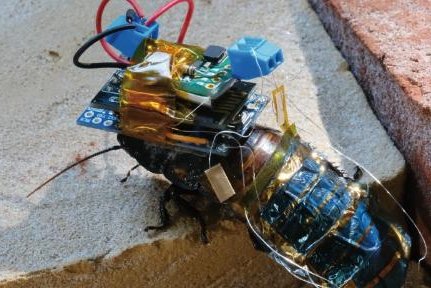DARPA TOYS
Solar-powered cyborg cockroaches could rescue humans, study says
Cyborg cockroaches, equipped with solar-powered backpacks,
can be steered remotely. Photo courtesy of Riken.
Sept. 6 (UPI) -- Scientists in Japan are tapping into solar power to harness cockroaches and their ability to access hard-to-reach areas for environmental monitoring, as well as search-and-rescue in the event of a natural disaster, according to a new study.
The cyborg cockroach study, published Monday in the journal npc Flexible Electronics, outlines how researchers at Riken research institute were able to engineer small solar-powered backpacks to remotely steer the legs of cockroaches.
The backpacks tapped into the nervous systems of Madagascar hissing cockroaches, giving researchers the ability to move the robotic roach in certain directions with the press of a wireless button.
While this is not a new idea, it is the first time researchers have used solar power instead of a battery that would eventually run out. The backpacks also had a power output about 50 times higher than previous devices.
Sept. 6 (UPI) -- Scientists in Japan are tapping into solar power to harness cockroaches and their ability to access hard-to-reach areas for environmental monitoring, as well as search-and-rescue in the event of a natural disaster, according to a new study.
The cyborg cockroach study, published Monday in the journal npc Flexible Electronics, outlines how researchers at Riken research institute were able to engineer small solar-powered backpacks to remotely steer the legs of cockroaches.
The backpacks tapped into the nervous systems of Madagascar hissing cockroaches, giving researchers the ability to move the robotic roach in certain directions with the press of a wireless button.
While this is not a new idea, it is the first time researchers have used solar power instead of a battery that would eventually run out. The backpacks also had a power output about 50 times higher than previous devices.

A better understanding of how exactly seals are using environmental resources could help alleviate concerns that local seal populations have grown too large, scientists say.
Photo by Krista Ingram/Colgate University
A 2015 study at Texas A&M used a battery-powered backpack that allowed researchers to successfully steer cockroaches to the left and right about 60 percent of the time.
In the new study, researchers found attaching a backpack, with solar capability, to an insect without restricting its movement was the tricky part. Riken tested various thin electronic films to see how the roaches moved and landed on a module 17 times thinner than a human hair.
With the solar-powered backpack attached, researchers were able to charge the battery with artificial sunlight for 30 minutes and then steer the roach to the left and right using a wireless system.

By looking more closely at where individual seals move,
scientists may be able to discern where sharks are likely to migrate.
Photo by Krista Ingram/Colgate University
"The current system only has a wireless locomotion control system, so it's not enough to prepare an application such as urban rescue," said Kenjiro Fukuda, an expert in flexible electronics at Riken.
"By integrating other required devices such as sensors and cameras, we can use our cyborg insects for such purposes."
While cockroaches are ideal for exploring nuclear and chemical disasters, since they are mostly immune to radiation, Fukuda says the ultra thin solar cell could be used on other insects, even flying ones, to allow humans to control their movements.
"Considering the deformation of the thorax and abdomen during basic locomotion, a hybrid electronic system of rigid and flexible elements in the thorax and ultrasoft devices in the abdomen appears to be an effective design for cyborg cockroaches," said Fukuda.
"Moreover, since abdominal deformation is not unique to cockroaches, our strategy can be adapted to other insects like beetles, or perhaps even flying insects like cicadas in the future."
No comments:
Post a Comment